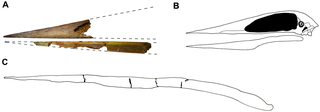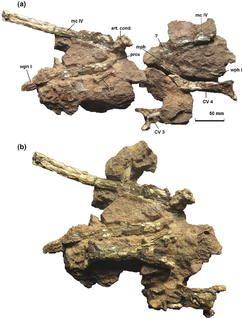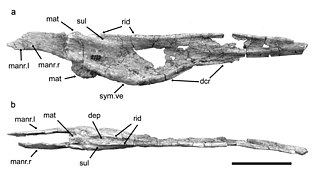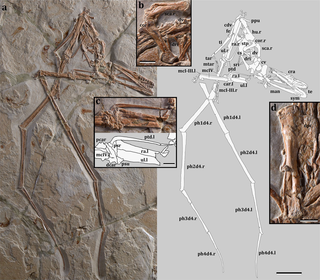
Azhdarchidae is a family of pterosaurs known primarily from the Late Cretaceous Period, though an isolated vertebra apparently from an azhdarchid is known from the Early Cretaceous as well. Azhdarchids included some of the largest known flying animals of all time, but smaller cat-size members have also been found. Originally considered a sub-family of Pteranodontidae, Nesov (1984) named the Azhdarchinae to include the pterosaurs Azhdarcho, Quetzalcoatlus, and Titanopteryx. They were among the last known surviving members of the pterosaurs, and were a rather successful group with a worldwide distribution. By the time of the end-Cretaceous mass extinction, most pterosaur families except for the Azhdarchidae disappear from the fossil record, but recent studies indicate a wealth of pterosaurian fauna, including pteranodontids, nyctosaurids, tapejarids and several indeterminate forms. In several analyses, some taxa such as Navajodactylus, Bakonydraco and Montanazhdarcho were moved from Azhdarchidae to other clades.

Montanazhdarcho is a genus of azhdarchoid pterosaur from the Late Cretaceous period of what is now the state of Montana, United States. Montanazhdarcho is known from only one species, M. minor.

Bakonydraco is a genus of pterodactyloid pterosaur from the Late Cretaceous period of what is now the Csehbánya Formation of the Bakony Mountains, Iharkút, Veszprém, western Hungary.

Nurhachius is a genus of istiodactylid pterodactyloid pterosaur from the Barremian to Aptian-age Lower Cretaceous Jiufotang Formation of Chaoyang, Liaoning, China. Its fossil remains dated back about 120 million years ago.

Aralazhdarcho is a genus of azhdarchid pterosaur from the Santonian to the early Campanian stages of the Late Cretaceous period of Bostobe Svita in Kazakhstan. The type and only known species is Aralazhdarcho bostobensis.

Cretornis is a pterosaur genus from the late Cretaceous period of what is now the Jizera Formation in the Czech Republic, dating to about 92 million years ago. It only contains a single species, Cretornis hlavaci.
Argiles et Grès à Reptiles Formation also known as the Argiles Rutilantes Formation is an early Maastrichtian French geologic formation in the département of Var preserving the remains of several types of dinosaurs and other extinct organisms.

Alanqa is a genus of pterodactyloid pterosaur from the Late Cretaceous period of what is now the Kem Kem Beds of southeastern Morocco. The name Alanqa comes from the Arabic word العنقاءal-‘Anqā’, for a mythical bird of Arabian culture.

Navajodactylus is an extinct genus of pterodactyloid pterosaur from Late Cretaceous deposits of the San Juan Basin in New Mexico, United States.
Batyrosaurus is an extinct genus of herbivorous basal hadrosauroid dinosaur known from the Late Cretaceous Bostobe Formation of central Kazakhstan. It contains a single species, Batyrosaurus rozhdestvenskyi. It is possible that Batyrosaurus represents the same taxon as the doubtful Arstanosaurus akkurganensis as both were found from the same formation.

Europejara is a genus of tapejarid pterosaur from the Early Cretaceous period of Spain. The type and only species known is Europejara olcadesorum.

Aerotitan is a genus of large azhdarchid pterosaur known from the Late Cretaceous period of what is now the Allen Formation of the Neuquén Basin in northern Patagonia, Argentina.

Eurazhdarcho is a genus of azhdarchid pterosaur from the Late Cretaceous period of what is now the Transylvanian Basin of Romania. Its fossil remains dated back 69 million years ago.
Xericeps is a genus of pterosaur from the Late Cretaceous Kem Kem Beds of southeastern Morocco.

Argentinadraco is an extinct genus of azhdarchoid pterosaur from the Late Cretaceous Portezuelo Formation of Argentina. It contains a single species, A. barrealensis, named in 2017 by Alexander Kellner and Jorge Calvo. Argentinadraco is unusual for bearing a bottom jaw with a concave bottom edge, as well as a pair of ridges and depressions on the top surface. These features distinguish it from all other azhdarchoid groups, complicating its assignment, but it may belong to the Chaoyangopteridae. The ridges on the lower jaw may have been used to feed on small invertebrates in loose sediment within the system of lakes and rivers that it resided in.

Cryodrakon is a genus of azhdarchid pterosaur that lived during the Late Cretaceous period in what is now Canada. It contains a single species, Cryodrakon boreas, recovered from the Dinosaur Park Formation.
Albadraco is an azhdarchid pterosaur genus that during the Late Cretaceous lived in the area of modern Romania. The type species is Albadraco tharmisensis.

Mimodactylus is a genus of mimodactylid pterodactyloid pterosaur from the Late Cretaceous of what is now Lebanon.

Apatorhamphus is an extinct genus of azhdarchoid pterosaur from the Kem Kem Group of Morocco. It might have been part of the Chaoyangopteridae. It is only known from a few snout fragments and it likely had a wingspan of between 3–7 metres (9.8–23.0 ft)
Thanatosdrakon is a genus of quetzalcoatline pterosaur from the Late Cretaceous Plottier Formation of the Neuquén Basin in western Argentina. The genus name is derived from the Greek words thanatos (=death) and drakon (=dragon), while the specific name is a Quechuan word meaning "flying serpent" and refers to the Incan deity Amaru. The type and only species is Thanatosdrakon amaru, known from two specimens consisting of several well-preserved axial and appendicular bones including material previously undescribed in giant azhdarchids. Thanatosdrakon is one of the oldest known members of the Quetzalcoatlinae. T. amaru lived from about 90 to 86 million years ago.




























